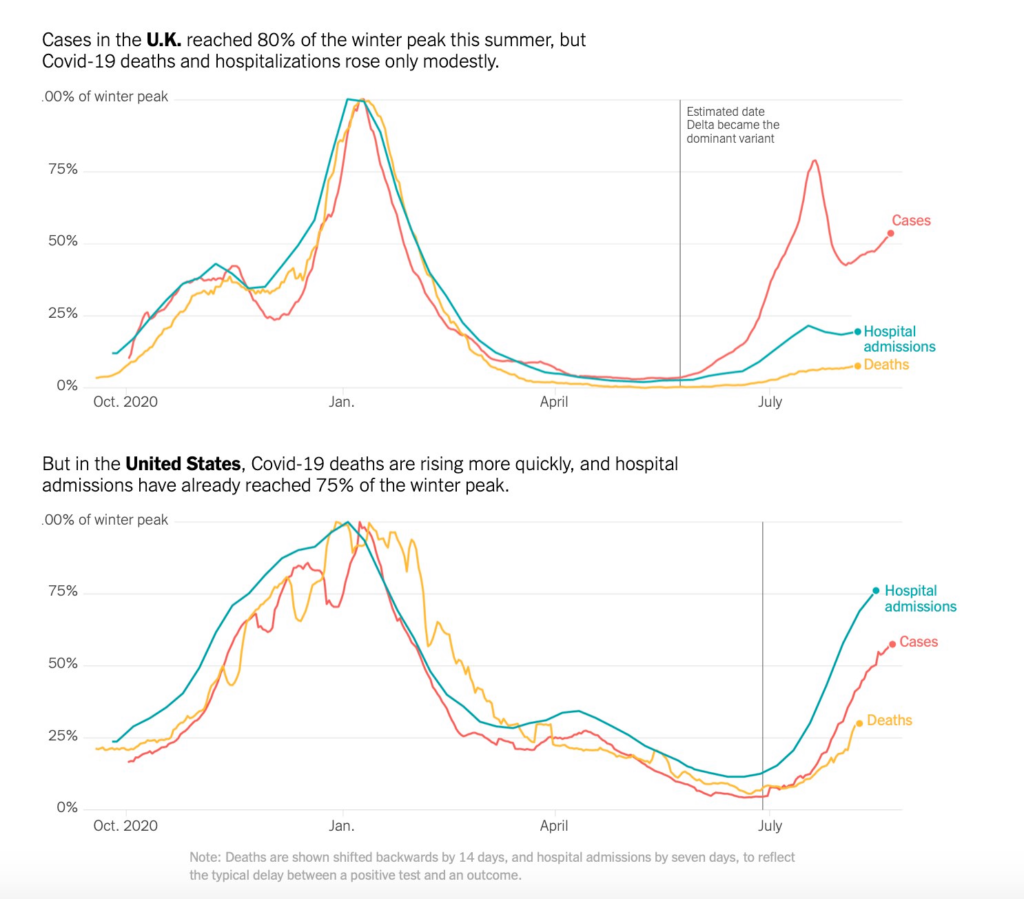A: It’s a mixed bag—cases *have* fallen from their peak but have now plateaued at a high level.
TL;DR:
➡️ Cases remain stuck at a high level in the UK, despite high vaccination rates (higher than the US). This speaks to the transmissibility of Delta and means things could get worse in the US.
➡️ Hospitalizations and deaths remain much lower (but not trivial) than previous waves, thanks to the vaccines.
Nerdy Girl (and American ex-pat in England) Jenn here- I was recently back in the U.S. for several weeks where the Delta surge felt like déjà vu (or a “pandoomerang”?) from early summer in the U.K. In my dreams the UK was going to get its Delta surge “sorted” while I was gone, and I could come back home to the high vaccination and low case rate nirvana we’re all longing for.
Meanwhile across the pond, cases in the UK took an unexpected nose dive around the time of the last step of re-opening on July 19th (so called “Freedom Day”), when many had predicted cases continuing their exponential rise up to 100,000 per day. So, great news, right? Perhaps Delta burns bright but fast?
While we all *hoped* that this unforeseen but happy downturn would be sustained and we could put Delta in the rear-view mirror, case numbers in the U.K. have since flattened at a still high level and are ticking up again. The 7-day rolling average of confirmed cases in the UK is at around 34,000 per day, down from a peak of over 47,000 in July, but still equivalent to the levels seen in the dangerous surge last December. Current case numbers are very similar to the confirmed cases per capita in the US, though the test positivity rate is much higher in the US vs UK (14% versus 3.5%), suggesting the US is missing a lot more cases.

❓What do we make of this decline and then plateau?
Scientists and armchair scientists alike– BE HUMBLE. The Delta surge in the UK despite its very high vaccination rate, followed by a surprising fall in cases while restrictions were being eased, followed by a flattening and increase rather than continued decline should remind us once again that HUMILITY is required in the face of this pandemic.
While we’ve learned a lot of important facts about the virus, predicting the precise twists and turns of the epidemic curve at the national or regional level has proven virtually impossible. When unexpected changes do happen, we often scramble for post-hoc explanations, many of which prove to be wrong when the course suddenly reverses again.
With cases rising exponentially and the government continuing to move forward with its re-opening plan that dropped many COVID-19 restrictions, many expected sky-rocketing cases. When that did not happen, explanations included:
➡️ schools closing (although the drop started first)
➡️ heat wave (finally summer weather in England, people getting outside!)
➡️ the “pingdemic” (thanks to spike in cases while England progressed to the Euro Cup finals, NHS test and trace pinged almost 620,000 in one week to quarantine after exposure.)
➡️ population immunity (a go-to explanation anytime cases fall around the world—but so far not true).
➡️ behavior change (people being more cautious due to spiking cases).
Here’s a piece on the collective head scratching in late July as cases fell.
With cases staying at a high level and ticking up again, the early celebrations have halted.
Delta is still a highly transmissible and formidable foe. Despite very high vaccination rates overall in the UK (88.3% of the population 16+ with at least one dose), there are still a lot of young people who are unvaccinated, and the 10-29 year old age group is the most represented in new cases. Delta tends to find those susceptible hosts very easily these days, like water finding the pavement cracks, leading to sustained high transmission.
While the Pfizer vaccine has been approved by the MHRA in the UK (similar to FDA) for ages 12+, the Joint Commission on Vaccination and Immunisation (JCVI) (similar to ACIP in the US), has not yet recommended vaccination for children under 16. 16–17-year-olds were only made eligible in recent weeks. The JCVI reportedly wanted more data for these ages from other countries to make sure the benefits of vaccination outweigh the risks after reports of myocarditis. This reluctance to vaccinate down to age 12 prior to school re-starting is hotly debated, and the British government recently suggested they would like 12–15-year-olds to be eligible for vaccination soon, but the ball is now in the JCVI’s court.
❓Is there any good news? What can the US learn from UK riding this Delta wave first?
Infections are happening more often at younger ages. This likely reflects both lower vaccination rates and more social contact as restrictions were lifted.
The good news is that despite very high and sustained case levels, hospitalizations and deaths have remained dramatically lower than previous waves in the UK thanks to vaccination.
Why is the US seeing a more dramatic rise in hospitalizations and deaths compared to the UK? This is likely due to differences in vaccine uptake- the UK has had better uptake especially at the most vulnerable ages of 65+. In the US around 80% of those 65+ are fully vaccinated, compared to over 95% in the UK. This may not sound like a big difference, but it means that there is a much higher fraction of those most vulnerable to hospitalization and death unprotected in the US, and this is sadly showing up in the severe cases and deaths.
While there are some regional differences, this high vaccine uptake has also been quite uniform across the UK compared to the US where some states have much lower vaccine uptake. This clustering of unvaccinated people leaves many more vulnerable to infection severe disease when outbreaks hit, as we are seeing now in several Southern states.
While the majority of those hospitalized in the UK are unvaccinated, the % who are vaccinated is higher than in the US. Somewhat counterintuitively, this is a GOOD thing and reflects that the UK has vaccinated almost all its most vulnerable people (read here for previous explainer).
❓What’s next?
My crystal ball has been clear as mud this whole pandemic. The renewed rise in cases seems to be slowing down in the UK overall, but cases are rising exponentially again in Scotland. With a highly vaccinated population, Delta may finally hit enough brick walls that it takes a real nosedive. On the other hand, schools start again soon, with virtually no vaccination for kids and very little in-school mitigations. Many are scheduled to return to offices in September as well. This leaves a lot of room for continued spread, combined with the typical autumn increase in respiratory viruses from moving indoors and more close contact.
Like Ted Lasso, I remain ever hopeful. #Believe
Keep calm and #VaxUp
Love,
Nerdy Girl Jenn
Further Reading
“Britons, Unfazed by High Covid Rates, Weigh Their ‘Price of Freedom’


